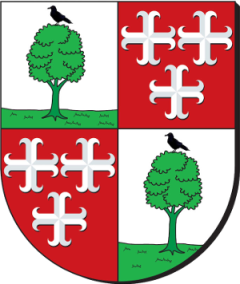The Reformed community of Stavenisse, a village on the island of Tholen, holds a very special listed monument in its church. It is the extremely valuable mausoleum of Hieronymus van Tuyll van Serooskerke, lord of Stavenisse. This grave is in urgent need of a very expensive restoration.
In 1953, the village was hit by the flood which killed 10% of the inhabitants and destroyed many buildings. The church did not escape the flood either and stood in the water. It now appears that the tomb is slowly being “eaten” away by the salty water.
The mausoleum with its back wall is made of white marble from Carrera (Italy), black marble, blue stone and black natural stone from Belgium. It was restored in 1878/79 and in 1959. At the last restoration, the crack in the left pilaster was already present, probably caused by rusty iron connections in the brick wall behind the marble. In the centre front of the tomb, a brownish-red discolouration can be seen, which has the same cause. More seriously, in several places the marble has become dull and very white, and is flaking off. This indicates that the rock has been saccharified, probably by a high salt load as a result of the flood of 1953. It is not clear how fast this degeneration proceeds, but the National Cultural Heritage Agency (RCE) advocates tackling it as soon as possible.
A plan has been drafted for this purpose. It provides for the parts of the tomb to be transported to a workshop in Amsterdam, where the salt is removed from the stone by rinsing it in a fresh water bath. This rinsing process takes one and a half to two years. It has to be checked daily, which is why it cannot take place in the church, where there is too little space. To remove the parts of the tomb, a wooden fence and the stairs near the pulpit will be temporarily removed. A work floor will then be laid, over which a small crane can gain access to the monument.
The State Service for Cultural Heritage describes the monument as follows:
“It was designed and executed by Rombout Verhulst, who alongside Artus Quellinus is probably the most famous Dutch sculptor of the 17th century. This memorial grave is mentioned in many publications and it is therefore clear that this is an extremely valuable piece of heritage.”
Prof. Dr. Frits Scholten, senior curator of sculpture at the Rijksmuseum and professor of History of Western Sculpture at the University of Amsterdam states:
“The funerary monument in the church of Stavenisse can without a doubt be counted among the best 17th-century sculpture in our country, but also belongs to the highly valuable funerary heritage from an international perspective. It is now clear that the decay goes much deeper than is visible to the naked eye and that intervention is therefore much more urgent than a general impression of the exterior might suggest.
The administrators have decided on a financial contribution to make the restoration of this special monument possible.

0 comments